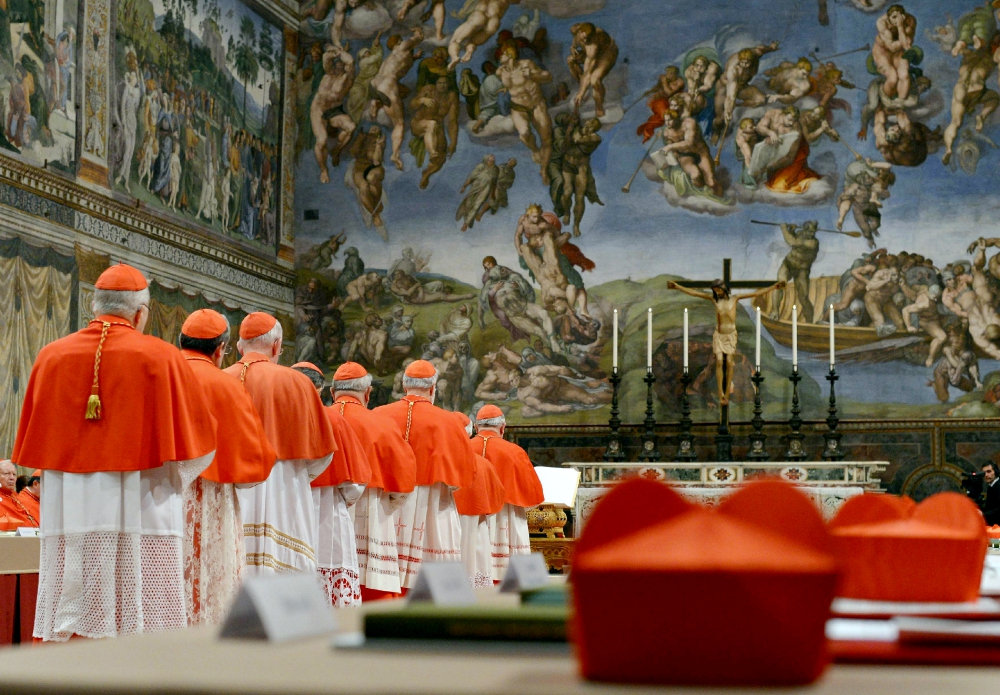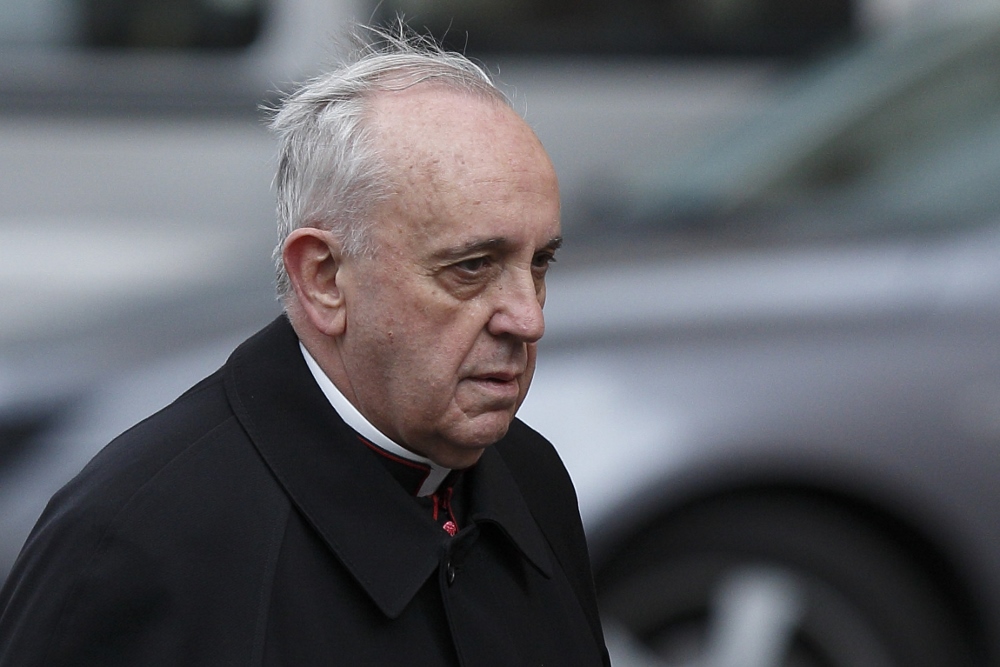
Cardinals from around the world are seen in the Vatican's Sistine Chapel March 12, 2013, as they begin the conclave to elect a successor to Pope Benedict XVI. (CNS/L'Osservatore Romano via Reuters)

Somewhere out there is a cardinal who has excommunicated himself latae sententiae! That is the conclusion one draws from reading Gerard O'Connell's newly published The Election of Pope Francis: An Inside Account of the Conclave that Changed History. We all have theories about what happened inside the Sistine Chapel during the conclave that elected Cardinal Jorge Mario Bergoglio as pope. O'Connell provides a ballot-by-ballot tally of the voting. It is unprecedented.
O'Connell begins his account, as one must, with the shocking and heroic decision by Pope Benedict XVI to resign the papacy, which he announced on Monday, Feb. 11. I recall speaking with a cardinal that morning who, when told the news as he headed into his morning Mass, assumed it was a prank, only to emerge from his prayers to find his iPhone chock-full of texts and emails confirming the news.
Very few people saw this coming, even though we now know Benedict had been moving toward his historic decision since at least the previous summer when he ordered the Visitandine cloistered nuns to vacate the Mater Ecclesiae Monastery behind St. Peter's for "renovations." This, he had decided, would serve as his home in retirement.
Benedict said he was moved to lay down his office because "in order to govern the barque of Saint Peter and proclaim the Gospel, both strength of mind and body are necessary, strength which in the last few months has deteriorated in me to the extent that I have had to recognize my incapacity to adequately fulfill the ministry entrusted to me." It is strange indeed that six years later, in recent weeks, conservative opponents have forgotten that the former pope telegraphed his incapacity so clearly as they have rushed to embrace his ill-advised commentary on the sex abuse crisis.
Speculation about a successor commenced immediately and tended to focus on a few well-known cardinals: Angelo Scola of Milan, Marc Ouellet of the Congregation for Bishops, Odilo Scherer of Sao Pãulo, Peter Erdo of Budapest, Hungary, Peter Turkson of the Pontifical Council for Justice and Peace.
NCR's Vatican correspondent at the time, John Allen, launched the candidacy of Cardinal Timothy Dolan: Allen had published a book-length interview with the gregarious archbishop of New York two years prior. But electing an American, especially someone as quintessentially American as Dolan, was never going to happen. The only American to generate real buzz and, according to O'Connell, got the fourth-highest number of votes on the first ballot at the conclave was Boston's Sean O'Malley, a Capuchin friar whose simplicity of lifestyle and sense of humor caught the attention of many.
O'Connell gives a day-by-day account of the time between Benedict's resignation and the day it took effect: Feb. 28. That night, he and his wife, Elisabetta Piqué, the Vatican correspondent for Argentina's daily La Nación, entertained to dinner an old friend at their home: Cardinal Bergoglio. He had baptized their children, who called him "Padre Jorge" and enjoyed his company that night as well.

Cardinal Jorge Mario Bergoglio arrives for the afternoon session of the general congregation meeting in the synod hall at the Vatican March 7, 2013. (CNS/Paul Haring)
It was commonly known that Bergoglio had been the runner-up at the 2005 conclave, but his name was not among the top-tier candidates this time. Most outside observers, including myself, considered that at age 76, he might be too old, especially as Benedict had just resigned on account of the effects of old age.
The cardinal electors would draw a different conclusion: If retirement was now to become a viable option, being a bit older was not an insuperable barrier to election. Also clear was that none of the cardinals wanted a long pontificate like that of John Paul II, who had been only 58 when he was elected in 1978 and served for 27 years.
On March 1, it was announced that the dean of the College of Cardinals, Cardinal Angelo Sodano, had sent a letter to all cardinals, inviting them to come to Rome for the pre-conclave general congregations, which were open to both cardinal electors and to those past the voting age of 80. The meetings would begin on March 4 but most of the cardinals were already in Rome.
O'Connell's years in the trenches become obvious as he explains how he had dinner on one night with a cardinal whom he had known for 20 years, and an interview the next morning with another whom he had known for a decade. And as these men he knew spoke to him about the discussions at the general congregations, it became obvious that the principal division among the cardinals was not between conservatives and progressives, nor between North and South. The key division was the Vatican Curia against everybody.
Advertisement
This anti-Curia dynamic doomed the candidacy of Scherer, who had long worked in the Curia and was seen as their candidate, but it did not necessarily point to Bergoglio. Indeed, it appears that his candidacy only caught fire in the last days before the conclave began, when he made his now famous intervention about Jesus knocking at the door, but knocking to get out of a sclerotic, self-referential church. Cardinal Jaime Ortega of Havana asked Bergoglio for a copy of his remarks. The future pope had not written a draft, only bullet points, but he subsequently wrote out his remarks for his Cuban friend who then shared them with the world.
I will not examine here O'Connell's tell-all about what happened inside the Sistine Chapel. For that, you need to buy the book. (And you will have to clear your calendar because this book, once started, is hard to put down.) I will say that reading it, I recalled the biographies of Popes John XXIII and Paul VI written by Peter Hebblethwaite. Those had included a chapter on the conclaves that resulted in their election, and I had wondered how he knew what had happened inside this most secret of events.
I had the same question reading O'Connell's account of the 2013 conclave. Who would have disclosed this? Who would have remembered the vote totals with such precision? How can we verify this account? I do not know the answers to those questions but I will tell you this: When I posed them to a cardinal, he replied, "I think Gerry nailed it."
[Michael Sean Winters covers the nexus of religion and politics for NCR.]
Editor's note: Don't miss out on Michael Sean Winters' latest: Sign up and we'll let you know when he publishes new Distinctly Catholic columns.




